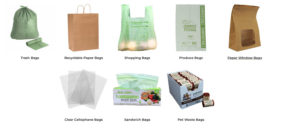
Reduce, Reuse, Refresh: How Reusable Food Storage Bags Can Cut Down Your Kitchen Waste
The kitchen is often regarded as the heartbeat of our homes. This is where we gather to prepare meals but it sometimes serves as a dining area, or if it is a home like mine we seldom have fun conversations when doing kitchen chores. The activity that takes place in the kitchen makes it easy to grow a pile of waste in there. Food scraps, uneaten leftovers, half-empty bags of snacks, and even plastic packaging are all forms of kitchen waste that contribute to the broader environmental issues we face today.
However, as society is becoming more environmentally conscious, many of us feel frustrated when we see trash can be filled with plastic bags and packaging. We might feel a twinge of guilt each time we throw away a single-use plastic bag, knowing it will linger in a landfill or pollute our oceans for centuries.
So how can we fix this challenge and cut down on kitchen waste? Allow me to introduce you to reusable food storage bags.
Understanding Reusable Food Storage Bags
 Reusable food storage bags are durable alternatives to single-use plastic bags. They come in various types, including silicone and fabric, each offering unique benefits. Silicone bags, for example, are heat-resistant and can be used in the microwave, freezer, and even for sous-vide cooking. Fabric bags, often made from organic cotton, are perfect for storing dry goods and produce. These bags are designed to be suitable for repeated use and are a versatile addition to any kitchen.
Reusable food storage bags are durable alternatives to single-use plastic bags. They come in various types, including silicone and fabric, each offering unique benefits. Silicone bags, for example, are heat-resistant and can be used in the microwave, freezer, and even for sous-vide cooking. Fabric bags, often made from organic cotton, are perfect for storing dry goods and produce. These bags are designed to be suitable for repeated use and are a versatile addition to any kitchen.
But, their true power lies in their impact on the environment. Every plastic bag you ditch is one less piece of plastic clogging landfills or polluting oceans. Imagine the collective difference we can make by simply switching to reusable options! The lifecycle of a reusable bag far exceeds that of a disposable one, meaning fewer bags are needed over time, which leads to less waste.
Materials and Safety
Reusable food storage bags are often made from safe, non-toxic materials like food-grade silicone and PEVA (polyethylene vinyl acetate). These materials ensure that no harmful chemicals leach into your food. When selecting reusable bags, look for certifications like FDA approval or European LFGB standards, which guarantee safety and quality.
Benefits of Using Reusable Food Storage Bags
Caring for Our Planet
Choosing reusable bags is a small but powerful step towards reducing plastic waste. Each reusable bag you use keeps numerous single-use plastics from polluting our precious landfills and oceans. By embracing this practice, you contribute to reducing pollution and safeguarding our ecosystems and wildlife from the harmful impacts of plastic waste.
Economic Benefits
While the initial investment in reusable bags might seem pricey, the cost savings over time is worth it. Disposable plastic bags, although cheap per unit, add up in cost over repeated purchases. Quality reusable bags can last for years, reducing the need for frequent replacements. To maximize their lifespan, follow care instructions such as avoiding harsh detergents and extreme heat. Over time, you will notice the economic benefits of this sustainable switch.
Convenience and Versatility
Reusable food storage bags are incredibly versatile. Beyond storing food, they can be used for organizing items, packing lunches, or even as travel bags for toiletries. Their ease of cleaning and maintenance adds to their convenience. Most silicone bags can be cleaned in the dishwasher, while fabric bags can be machine-washed. By simplifying kitchen organization and reducing clutter, these bags make your life easier while promoting sustainability.
Implementing Reusable Food Storage Bags in Your Kitchen
Transitioning from disposable to reusable bags doesn’t have to be overwhelming. You cannot go wrong if you follow the guide below:
Step-by-Step Guide
- Start small by purchasing a few bags and using them for specific purposes, like storing snacks, grocery shopping, or packing lunches. Gradually increase usage as you become more comfortable.
- As you get more comfortable with using reusable bags for one purpose, start using them for others, such as carrying books, transporting sports equipment, or even as a substitute for smaller plastic bags used for fruits and vegetables.
- Choose wisely and select bags that meet your needs based on size, material, and functionality (for instance, silicone for liquids and cooking and fabric for dry goods).
- Look for bags that are easy to clean. Machine-washable bags are a great option if you are looking to minimize hassle. Remember, cleanliness is key to preventing bacteria buildup, especially in bags used for groceries.
- If you are often on the go, consider collapsible bags that can be easily tucked into your everyday bag or car.
- You can also consider going for reusable bags with designs that you love. You are more likely to remember and enjoy using bags that visually appeal to you or have a functional design.
Now, all your efforts may amount to nothing if everyone in the family is not on board with using these eco-friendly food storage bags. Educate family members, especially children, about the environmental benefits and the importance of sustainability. Create fun activities, like decorating fabric bags, to engage kids. Incorporate reusable bags into daily routines by packing lunches and snacks together. Consistent use will help form sustainable habits that benefit the entire household.
Conclusion
Switching to reusable food storage bags is a practical and impactful step towards reducing kitchen waste. These bags offer numerous benefits, from environmental and economic advantages to convenience and versatility. By adopting reusable bags, you contribute to a healthier planet and a more organized kitchen. Start small, educate your household, and enjoy the positive changes this sustainable practice brings.